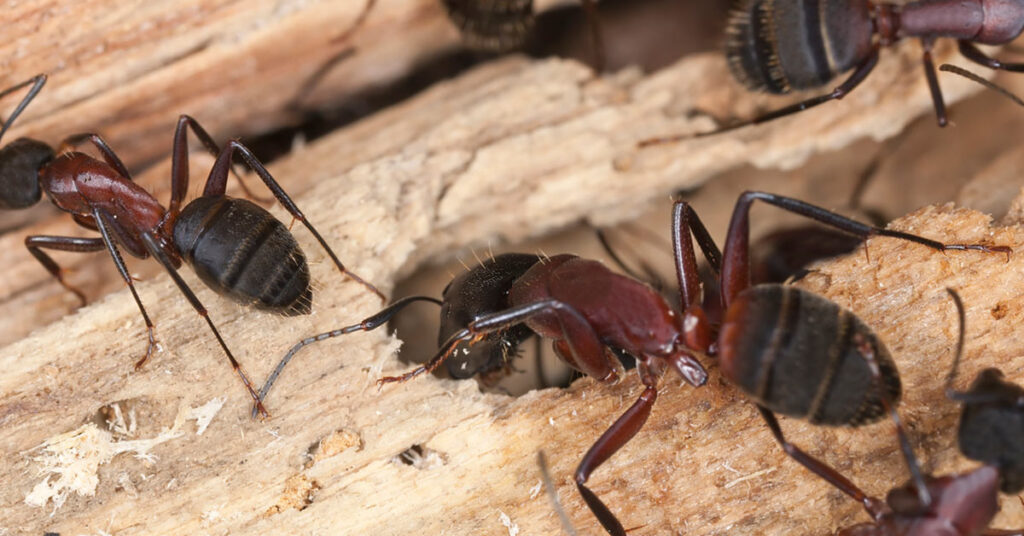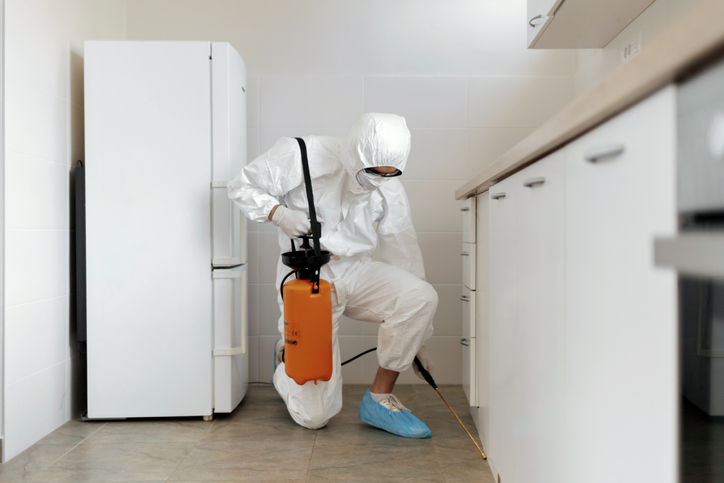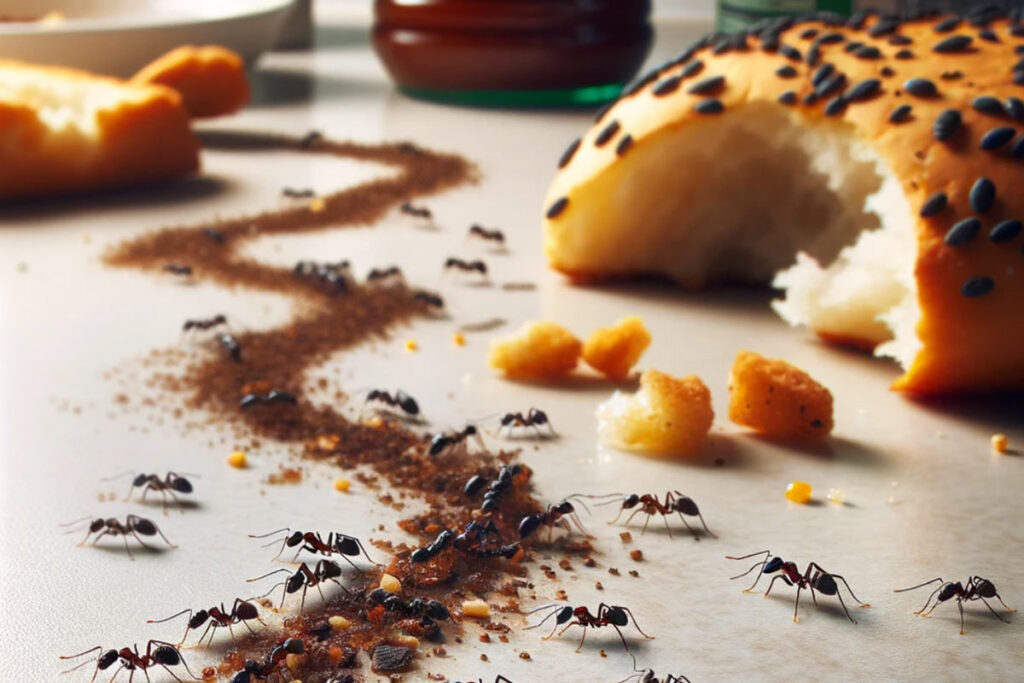Carpenter Ants vs. Termites
Carpenter ants and termites are two of the most common wood-destroying pests in homes. While carpenter ants excavate wood to build their nests without eating it, termites feed on wood, causing more extensive structural damage. Signs of carpenter ant infestations include sawdust-like shavings and large, segmented ants, whereas termites create shelter tubes and are often detected by the presence of winged termites or damaged wood. Early detection and professional pest control are crucial in preventing and mitigating the damage caused by these pests
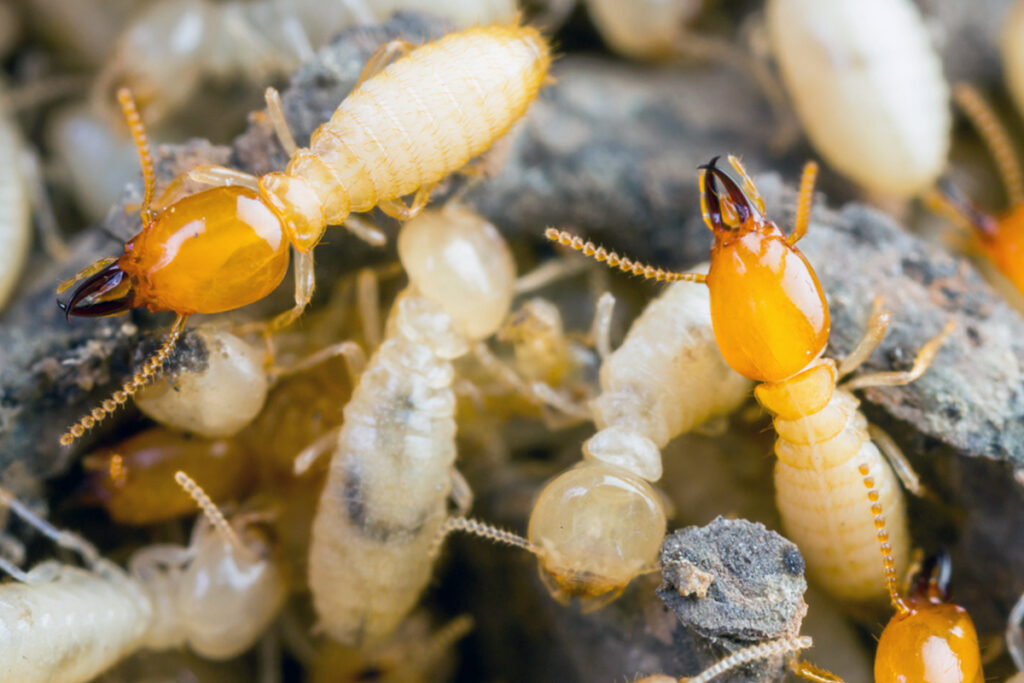
Table of Contents
- Carpenter Ants: Silent Destroyers of Wood
- Termites: The Hidden Menace
- Key Differences Between Carpenter Ants and Termites
- Proactive Measures for Prevention and Control of Carpenter Ants and Termites
- Navigating the Threat of Carpenter Ants and Termites
- Frequently Asked Questions About Carpenter Ants and Termites
In the realm of household pests, few are as notorious and damaging as carpenter ants and termites. These tiny invaders, often unseen until the damage is done, pose a significant threat to the structural integrity of homes and buildings. While they may seem similar at first glance, due to their affinity for wood, carpenter ants and termites have distinct characteristics and behaviors that set them apart. Understanding these differences is crucial for homeowners, as it guides effective strategies for detection, prevention, and control.
Carpenter ants, known for their ability to hollow out wood, create intricate galleries to establish their colonies. Unlike termites, they do not consume the wood but remove it to make space for their nests. These ants are typically attracted to moist, decaying wood, often a result of water damage or exposure to the elements. The presence of carpenter ants can be identified by telltale signs such as fine wood shavings and the sighting of large, black or dark-colored ants.
On the other hand, termites, particularly the subterranean species, are infamous for their destructive feeding habits. These pests consume wood, causing severe and often extensive damage to the structural components of a building. Termites are more discreet in their activities, often going unnoticed until significant damage has occurred. They are typically found in the soil around buildings and are known to create mud tubes or shelter tubes for protection and moisture retention.
Both carpenter ants and termites can cause substantial damage to homes, leading to expensive repairs and structural compromises. However, their differing behaviors and impacts necessitate tailored approaches for effective management and control. This article delves into the world of these wood-destroying pests, offering insights into their behavior related to home infestations, potential for structural damage, cost implications, and health concerns for people and pets. With a blend of technical information and practical advice, this guide aims to equip homeowners with the knowledge needed to protect their homes from these silent destroyers.
Carpenter Ants: Silent Destroyers of Wood
Carpenter ants, often referred to as the silent destroyers of wood, play a unique and often misunderstood role in the ecosystem of household pests. These ants, while not as widely destructive as termites, can still cause significant damage to wooden structures over time. Understanding their behavior, habitat, and the signs of their presence is crucial for homeowners to effectively manage and prevent infestations.
Behavior and Habitat
Carpenter ants are primarily nocturnal insects, known for their preference for moist, decaying wood to establish their colonies. Unlike termites, they do not consume wood for nutrition. Instead, they excavate wood to create smooth, hollowed-out galleries to house their nests. This behavior is often driven by the ant’s need for a suitable, humid environment to thrive, which is why they are frequently found in areas with water damage or excessive moisture.
These ants are attracted to wood softened by fungal decay, often entering buildings through cracks, vents, or where utility pipes and wires penetrate the walls. Once inside, they can extend their network into sound wood, creating extensive colonies that can span several rooms or areas of a house.

Identification and Signs of Infestation
Carpenter ants are larger than most other ant species, typically ranging from 6 to 12 mm in length. They are usually black but can also have reddish or yellowish coloration. The presence of carpenter ants is often indicated by the appearance of small, sawdust-like shavings known as frass. This frass is the result of their excavation activities and can often be found beneath wooden items or entry points into their nests.
Another sign of carpenter ant activity is the faint rustling noise they make as they move through their galleries. Homeowners may also observe an increased activity of large ants, particularly in the evening or at night, as they forage for food.
Potential for Structural Damage
While carpenter ants do not cause damage as rapidly as termites, their long-term presence can lead to significant structural damage. They typically target areas where wood is weakened by moisture, such as window frames, door frames, and areas near leaks in roofs or pipes. Over time, their excavation can weaken structural beams and other wooden elements of a house, potentially leading to costly repairs.
Control and Prevention
Effective control of carpenter ants involves a combination of methods. Eliminating sources of moisture and decaying wood is crucial in making the environment less attractive to these ants. Sealing entry points and cracks in the foundation or around utility lines can help prevent them from entering the home.
In cases of an established infestation, professional pest control services are often necessary. These experts can identify the extent of the infestation, locate the nests, and use appropriate methods to eradicate the ants.
Early detection is key in managing pest infestations. The sooner you identify a problem, the easier and less costly it is to control. Regular inspections, especially in vulnerable areas of your home, can prevent small issues from becoming major infestations.
Termites: The Hidden Menace
Termites primarily feed on cellulose, a component found in wood, making homes a perfect target for these pests. Subterranean termites, the most common and destructive type, live in colonies underground from where they tunnel to their food sources. These termites require a moist environment to survive and are often found in soil near or under buildings. They build distinctive mud tubes to provide moisture while they travel between their colony and food source.
Drywood termites, another common species, infest wood directly and do not require contact with the soil. They are often found in attic wood and can be transported to new locations via infested furniture.
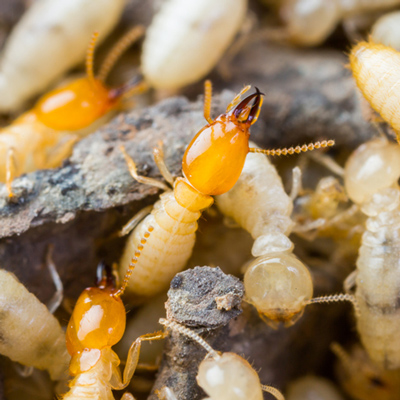
Identification and Signs of Infestation
Termites are elusive creatures, often going undetected until significant damage has been done. Signs of a termite infestation include:
Mud Tubes: Subterranean termites build mud tubes on exterior walls, foundations, and other structures to travel between their colony and food source. These tubes are a clear sign of termite presence.
Damaged Wood: Wood that sounds hollow when tapped, or that is visibly damaged with a honeycomb pattern, can indicate termite activity. Termites often eat wood from the inside out, leaving a thin veneer of timber or paint.
Swarmers and Discarded Wings: The presence of winged termites, known as swarmers, inside a home, or the discovery of discarded wings near window sills and doors, can signal an active termite infestation.
Potential for Structural Damage
Termites can cause catastrophic damage to homes, often without any immediate signs to the untrained eye. They can weaken the structural integrity of a building, leading to costly repairs. According to experts, termites cause billions of dollars in damage each year, often not covered by homeowners’ insurance.
Control and Prevention
Termite control requires a multifaceted approach. Preventative measures include reducing moisture around the foundation, maintaining proper ventilation in crawl spaces, and removing potential food sources such as wood debris near the home. Regular inspections by pest control professionals are crucial in early detection and management of termite infestations.
In cases of an active infestation, professional pest control services are necessary. They can provide effective treatment options such as soil treatment, bait systems, or direct wood treatment, depending on the type and extent of the infestation.
Key Differences Between Carpenter Ants and Termites
Understanding the differences between carpenter ants and termites is crucial for homeowners to effectively identify and manage these pests. While both can cause significant damage to wooden structures, their distinct characteristics and behaviors require different approaches for control and prevention.
| Cost Type | Carpenter Ants | Termites | Notes |
|---|---|---|---|
| Immediate Treatment Costs | $250 – $1,000 | $500 – $2,500+ | Costs vary based on infestation size and treatment method. |
| Structural Repair Costs | $500 – $5,000+ | $3,000 – $10,000+ | Depends on the extent of damage and area of repair. |
| Long-Term Costs | Variable | Variable | Includes recurring treatments and ongoing repairs. |
| Preventive Measures and Maintenance | $100 – $300 annually | $100 – $300 annually | Regular inspections, moisture control, etc. |
| Insurance Considerations | Not typically covered | Not typically covered | Most policies consider it a maintenance issue. |
| Indirect Costs | Variable | Variable | Time, effort, stress, and potential health concerns. |
Immediate Treatment Costs:
- Carpenter Ants: The cost of eradicating a carpenter ant infestation typically involves professional pest control services. While generally less expensive than termite treatment, the cost can vary depending on the extent of the infestation and the size of the property.
- Termites: Termite treatment is often more costly due to the need for more extensive and specialized methods, such as soil treatment, bait systems, or fumigation. The cost can increase significantly for larger infestations or in cases where multiple treatments are necessary.
Structural Repair Costs:
- Carpenter Ants: While the structural damage caused by carpenter ants is usually less severe than that caused by termites, significant infestations can lead to the need for repairs, especially in areas where wood has been weakened.
- Termites: Termites can cause extensive structural damage that often goes unnoticed until it becomes severe. Repair costs can range from minor fixes to substantial reconstruction, potentially costing thousands of dollars.
Long-Term Costs:
Both pests can lead to long-term costs if not properly managed. Repeated infestations can result in recurring treatment expenses and ongoing structural repairs. Additionally, severe infestations can diminish the value of a property, affecting its resale value.
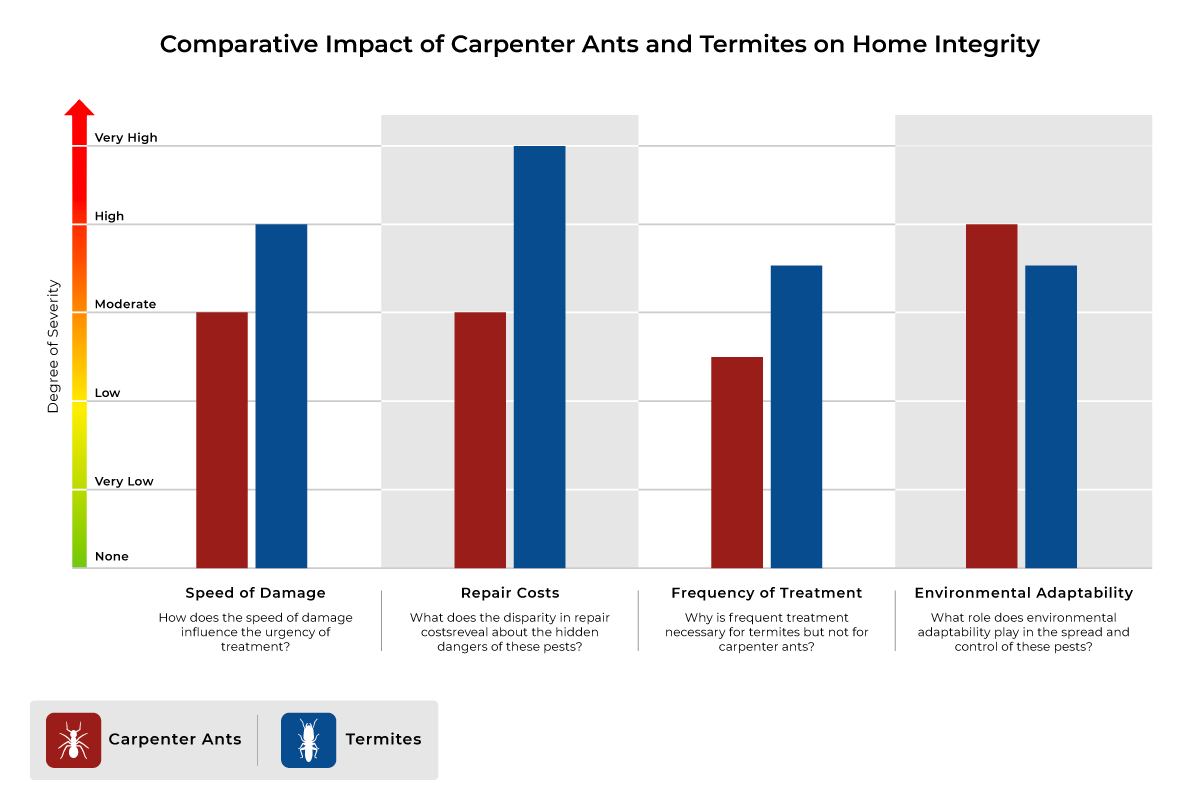
Preventive Measures and Maintenance:
Investing in preventive measures, such as regular inspections, moisture control, and sealing entry points, can incur costs. However, these expenses are generally lower compared to the costs associated with treating an active infestation and repairing damage.
Insurance Considerations:
Most homeowners’ insurance policies do not cover damage caused by termites or carpenter ants, considering it a maintenance issue. This lack of coverage further emphasizes the importance of prevention and early detection.
Indirect Costs:
Beyond the direct financial impact, there are indirect costs such as the time and effort spent dealing with infestations, the stress associated with pest invasions, and potential health concerns from chemical treatments.
Health Concerns
While carpenter ants and termites do not pose direct health risks to humans or pets, the secondary effects of their presence can be concerning. The weakening of structural elements in homes can lead to accidents, and the presence of pest control chemicals, if not handled properly, can pose health risks.
Proactive Measures for Prevention and Control of Carpenter Ants and Termites
The battle against carpenter ants and termites is not only about dealing with infestations as they occur but also about taking proactive steps to prevent these pests from becoming a problem in the first place. Prevention is key in managing these destructive insects, and there are several strategies homeowners can implement to protect their homes.
Moisture Control:
Both carpenter ants and termites thrive in moist environments. Ensuring that your home is free from excess moisture is crucial. Repair leaky faucets, water pipes, and AC units. Ensure that water drains away from your home’s foundation and that crawl spaces, attics, and basements are well-ventilated and dry.
Wood-to-Ground Contact:
Avoid direct wood-to-ground contact around your home. This includes lumber, firewood, or any other wooden materials that should be stored away from the home’s foundation. Termites can easily access the house through these materials.
Seal Entry Points:
Regularly inspect the foundation of your home for cracks and crevices. Seal any openings with caulk or another appropriate material. This not only prevents ants and termites from entering but also enhances your home’s energy efficiency.
Trim Trees and Shrubs:
Keep trees and shrubs trimmed away from your home. Overhanging branches can provide a pathway for carpenter ants and other pests to enter your home.
Regular Inspections:
Conduct regular inspections of your home, both inside and out. Look for signs of infestations such as mud tubes, wood damage, or the presence of the pests themselves. Early detection can prevent extensive damage.
Professional Pest Control Services:
Consider scheduling annual inspections with a professional pest control service. They can provide a more thorough examination of your home and offer treatment options if necessary.
Dealing with carpenter ants or termites isn’t a one-time event. It’s about creating a long-term management plan that includes regular monitoring and preventive measures. This is where professional services really add value, helping homeowners maintain a pest-free environment over time.
Use Treated Wood in Construction:
When building or repairing your home, use treated wood that is resistant to termites and other pests. This can be especially effective in areas prone to moisture.
Proper Landscaping:
Ensure proper drainage in your landscaping to prevent water accumulation near the foundation. Use mulch sparingly as it can retain moisture and attract termites.
Dispose of Waste Properly:
Regularly dispose of waste and debris around your property. Rotting wood and piles of leaves can create ideal nesting sites for carpenter ants.
Educate Yourself and Your Family:
Stay informed about the habits and signs of carpenter ants and termites. Educating yourself and your family can help in early detection and prevention.
By implementing these proactive measures, homeowners can significantly reduce the risk of carpenter ant and termite infestations. It’s about creating an environment that is less attractive to these pests and being vigilant in monitoring and maintenance. Prevention, combined with prompt action at the first sign of an issue, is the most effective strategy in protecting your home from these silent destroyers.
Navigating the Threat of Carpenter Ants and Termites
The silent and often unseen threat posed by carpenter ants and termites to our homes is a matter of serious concern. These pests, capable of causing significant structural damage, demand a proactive and informed approach from homeowners. The journey through understanding their behaviors, identifying signs of infestation, and grappling with the financial implications highlights the critical need for vigilance and action in the realm of home maintenance and safety.
The key takeaway for homeowners is the importance of early detection and intervention. Regular inspections by professionals can uncover potential problems before they escalate into costly repairs. Simple preventive measures, such as maintaining a dry environment, repairing leaks promptly, and ensuring proper ventilation, can go a long way in deterring these pests.
However, when infestations are detected, timely and professional pest control services become indispensable. The cost of such services and subsequent repairs, although potentially significant, pales in comparison to the extensive damage and financial burden that unchecked infestations can cause. It’s a clear case where an ounce of prevention is worth a pound of cure.
Moreover, the journey doesn’t end with eradication. Continuous monitoring and maintenance are essential to prevent re-infestations. Homeowners must remain vigilant, understanding that these pests are a part of our environment and can re-emerge if conditions become favorable again.
The impact of carpenter ants and termites extends beyond the physical damage to our homes. It touches on the safety and well-being of our families. Living in a structurally compromised home poses risks, and the stress and disruption caused by large-scale pest infestations and repairs can take a toll on family life.
In conclusion, the battle against carpenter ants and termites is ongoing. It requires awareness, preparedness, and a commitment to maintaining our homes as safe havens. By embracing proactive measures, seeking expert advice, and acting swiftly at the first signs of trouble, homeowners can effectively safeguard their homes against these hidden destroyers. Remember, the health and safety of our homes and families are in our hands, and with the right approach, we can keep these silent threats at bay.
Frequently Asked Questions About Carpenter Ants and Termites
What are the main differences between carpenter ants and termites?
Carpenter ants are larger, have a narrow waist, and bent antennae. They excavate but do not eat wood. Termites are smaller, have a thick waist, straight antennae, and consume wood, often causing more extensive damage.
How can I tell if I have a carpenter ant or termite infestation?
Look for frass (wood shavings) and large ants for carpenter ants. For termites, check for mud tubes on walls, damaged wood, and swarms of winged termites or discarded wings.
Are carpenter ants and termites dangerous to humans?
Neither carpenter ants nor termites are directly harmful to humans; however, they can cause significant structural damage to homes, which can indirectly pose safety risks.
What should I do if I find termites or carpenter ants in my home?
Contact a professional pest control service for an assessment and treatment plan. DIY methods are often not effective for complete eradication.
Can carpenter ants and termites be prevented?
Yes, through moisture control, sealing entry points, maintaining a gap between soil and wood structures, and regular inspections.
How often should I inspect my home for these pests?
It’s recommended to inspect your home annually, especially if you live in an area prone to these pests. Professional inspections can be more thorough.
Will regular home insurance cover damage caused by these pests?
Most home insurance policies do not cover damage caused by carpenter ants or termites, as it’s considered preventable through regular maintenance.
Can carpenter ants and termites infest homes in colder climates?
Yes, while less common, both pests can be found in colder climates, especially carpenter ants, which seek shelter in warmer environments like homes.
What are the long-term effects of untreated carpenter ant and termite infestations?
Untreated infestations can lead to severe structural damage, potentially compromising the integrity of your home and leading to expensive repairs.
Are there eco-friendly options for treating these pests?
Yes, many pest control companies offer eco-friendly treatment options. Discuss these alternatives with your pest control provider.


